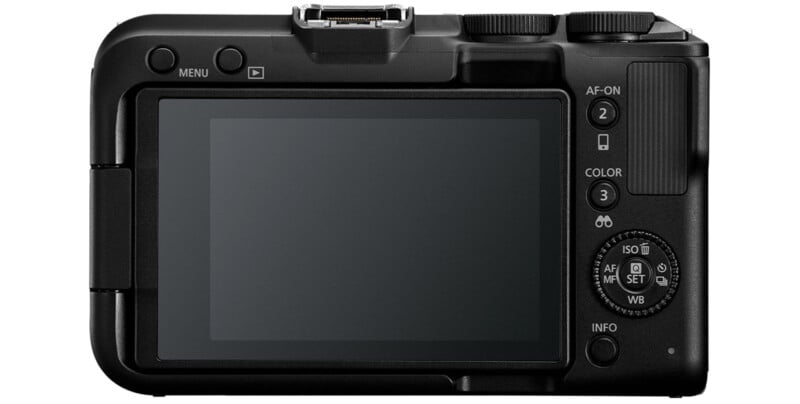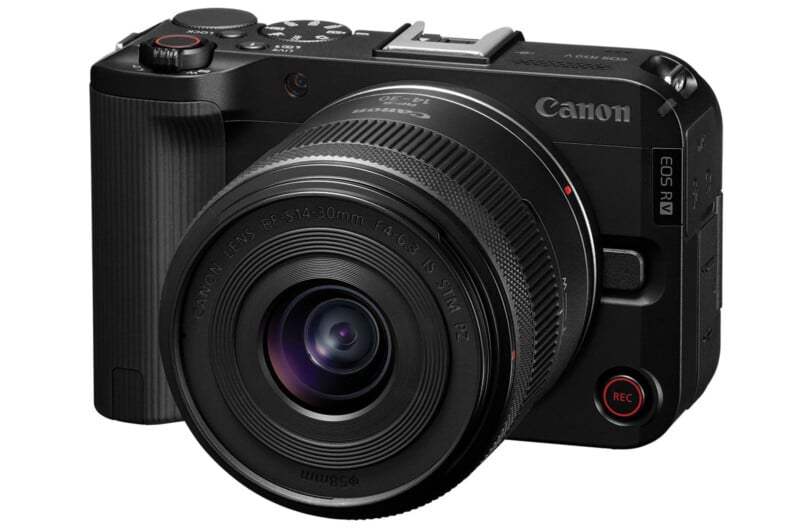The Canon EOS R50 V Offers Some EOS Cinema Features at a Low Price
![]()
The Canon EOS R50 V is designed from the ground up to deliver a very lightweight version of the Canon EOS Cinema experience to an entry-level video audience.
While a far cry from a full-blooded Canon EOS C series camera, the EOS R50 V has a lot of video-oriented features and targets a hybrid or video-first audience. The EOS R50 V includes video-friendly functions like false color, Canon C-Log 3, 10-bit YCC 422 video, 4-channel audio, and dedicated headphone, mic, and remote control terminals. There are some less-pro aspects, too, including using a Micro HDMI (Type D) port.

The Canon EOS R50 V is also targeted more at social media creators, so the camera is at home shooting vertically as it is horizontally. The camera’s control layout is designed for both orientations, including a front recording button and dedicated live stream button, orientation-sensitive menus, and a 1/4-20 slot on the side of the camera’s grip (there is one on the bottom, too). As Canon puts it, “The legacy of Cinema EOS technologies is splashed throughout” the EOS R50 V.
On the inside of the EOS R50 V is Canon’s tried-and-true 24-megapixel APS-C CMOS image sensor, which features Dual Pixel CMOS AF, and the DIGIC X image processor. While the camera can capture full-resolution RAW and JPEG images at a reasonably swift 15 frames per second using its electronic shutter, it is clearly aimed at a video-first user.
The Canon R50 V records 4K video at up to 60p frame rates, albeit with a 1.4 times crop. For users requiring the full width of the sensor, perhaps to take advantage of the wide-angle focal length of the new RF-S 14-30mm f/4-6.3 IS STM PZ lens, 4K recording is capped at 30p. It is worth noting that in addition to the false color display, the R50 V also includes audio level indicators during recording, and users can quickly adjust the white balance via Kelvin values through the camera’s quick menu.
Canon has also placed a heavy emphasis on live streaming. The EOS R50 V supports UVC/UAV 4Kp60 streaming, while the standard R50 tops out at 1080p60. The new R50 V also supports wireless streaming through Camera Connect and Live Switcher Mobile.
In Canon’s compact hybrid and video camera lineup, which comprises the PowerShot V10, the new PowerShot V1, and now the EOS R50 V, Canon positions the EOS R50 V at the top of the heap thanks to its larger APS-C image sensor and ability to accept interchangeable lenses. Although the PowerShot V1 also has C-Log 3 recording, the EOS R50 V promises improved video quality and versatility. Ultimately, choosing between the PowerShot V1 and EOS R50 V comes down primarily to whether consumers want an all-in-one camera or not.
![]()
The Canon EOS R50 V features Canon’s latest autofocus modes, many of which are inherited from the Canon EOS R6 Mark II full-frame camera. The R50 V’s Dual Pixel CMOS AF system covers approximately 100% of the APS-C image area, offers AI-powered subject detection and tracking (people, animals, and vehicles), and eye-detect AF for people and animals.
In pursuit of being an optimal video camera, some features that many EOS R series photographers are used to are omitted with the EOS R50 V. It is the first EOS R series camera to lack an electronic viewfinder, for example, and also omits a built-in flash.

Instead of an EVF, users must operate the camera through its three-inch rear monitor, which has 1.04 million dots and flips outward for vertical and self-facing recording.
The EOS R50 V is approximately 119.3 by 73.7 by 45.2 millimeters (4.7 by 2.9 by 1.8 inches), weighing 370 grams (13 ounces) with its battery and an SD card inserted. The camera has a single UHS-II SD card slot. For reference, the standard EOS R50, which has an EVF, weighs 375 grams (13.2 ounces).

Pricing and Availability
The Canon EOS R50 V will be available in April in body only ($649.99) and in a kit with the new RF-S 14-30mm f/4-6.3 IS STM PZ lens ($849.99).
Image credits: Canon